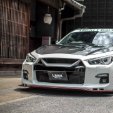Air Filters
Announcements
-
Similar Content
-
Latest Posts
-
Tried to make 1/8npt threads into compressor house of the turbo for my EBC. Threads got fu#ked and ended up with and elongated hole, so I do have good amount and nice threads 90% of the hole but 10% I only had 1-2threads there and rest of it is flush on that side of the hole.. So my idea is to do M12 x 1.25 to AN4 with braided lines instead of 1/8npt to 4mm vacuum silicone hose. and hopefully get a better thread. M12 is quite big and AN4 is a little bit bigger than 4mm (4.9mm inner diameter braided PTFE hose). but this should work. Thoughts? Otherwise I will weld and adapter onto the turbo.
-
Looks great, I hope everything is working well after all that time!
-
Finally back on the ground and once around the block for the first time in 2+ years
-
Ok a solution was found. I had left the factory oil temp sensor in and it was hooked up. My car never had the triple gauges. Apparently when you delete the factory pressure and leave the temp sensor connected it triggers the oil light on the dashboard. Disconnected the temp sender, no more light. I still haven't gotten around to look at the diagrams to figure out how/why they are tied together.
-





Recommended Posts
Create an account or sign in to comment
You need to be a member in order to leave a comment
Create an account
Sign up for a new account in our community. It's easy!
Register a new accountSign in
Already have an account? Sign in here.
Sign In Now